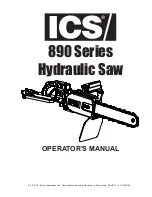
13 ENGLISH
Hook
CAUTION:
Always remove the battery when
hanging the tool with the hook.
CAUTION:
Never hook the tool at high loca-
tions or on the surfaces where the tool may lose
the balance and fall.
Otherwise falling accident may
occur and cause serious injury.
CAUTION:
Do not pull the tool downward
when it is hooked.
CAUTION:
Use the hanging/mounting parts
for their intended purposes only.
Using for unin-
tended purpose may cause accident or personal
injury.
The hook is convenient for hanging the tool temporarily.
To use the hook, simply lift up hook until it snaps into
the open position.
When not in use, always lower hook until it snaps into
the closed position.
►
Fig.25:
1.
Hook
2.
Open position
3.
Closed position
►
Fig.26
Rip fence (Guide rule)
Optional accessory
The handy rip fence allows you to do extra-accurate
straight cuts. Simply slide the rip fence up snugly
against the side of the workpiece and secure it in posi-
tion with the clamping screw on the front of the base. It
also makes repeated cuts of uniform width possible.
►
Fig.27:
1.
Rip fence (Guide rule)
2.
Clamping screw
Lanyard (tether strap) connection
Safety warnings specific for use at height
Read all safety warnings and instructions.
Failure
to follow the warnings and instructions may result in
serious injury.
1.
Always keep the tool tethered when working
"at height". Maximum lanyard length is 2 m
(6.5 ft).
The maximum permissible fall height for lan-
yard (tether strap) must not exceed 2 m (6.5 ft).
2.
Use only with lanyards appropriate for this tool
type and rated for at least 7.0 kg (15.4 lbs).
3.
Do not anchor the tool lanyard to anything on
your body or on movable components. Anchor
the tool lanyard to a rigid structure that can
withstand the forces of a dropped tool.
4.
Make sure the lanyard is properly secured at
each end prior to use.
5.
Inspect the tool and lanyard before each use
for damage and proper function (including
fabric and stitching). Do not use if damaged or
not functioning properly.
6.
Do not wrap lanyards around or allow them to
come in contact with sharp or rough edges.
7.
Fasten the other end of the lanyard outside
the working area so that a falling tool is held
securely.
8.
Attach the lanyard so that the tool will move
away from the operator if it falls.
Dropped tools
will swing on the lanyard, which could cause injury
or loss of balance.
9.
Do not use near moving parts or running
machinery.
Failure to do so may result in a crush
or entanglement hazard.
10.
Do not carry the tool by the attachment device
or the lanyard.
11.
Only transfer the tool between your hands
while you are properly balanced.
12.
Do not attach lanyards to the tool in a way that
keeps guards, switches or lock-offs from oper
-
ating properly.
13.
Avoid getting tangled in the lanyard.
14.
Keep lanyard away from the cutting area of the
tool.
15.
Use multi-action and screw gate type cara-
bineers. Do not use single action spring clip
carabineers.
16.
In the event the tool is dropped, it must be
tagged and removed from service, and should
be inspected by a Makita Factory or Authorized
Service Center.
►
Fig.28:
1.
Hole for lanyard (tether strap)
MAINTENANCE
CAUTION:
Always be sure that the tool is
switched off and the battery cartridge is removed
before attempting to perform inspection or
maintenance.
CAUTION:
Clean out the upper and lower
guards to ensure there is no accumulated saw-
dust which may impede the operation of the lower
guarding system.
A dirty guarding system may limit
the proper operation which could result in serious
personal injury. The most effective way to accomplish
this cleaning is with compressed air.
If the dust is
being blown out of the guards, be sure the proper
eye and breathing protection is used.
CAUTION:
After each use, wipe off the saw
dust on the tool.
Fine saw dust may come inside the
tool and cause malfunction or a fire.
NOTICE:
Never use gasoline, benzine, thinner,
alcohol or the like. Discoloration, deformation or
cracks may result.
To maintain product SAFETY and RELIABILITY,
repairs, any other maintenance or adjustment should
be performed by Makita Authorized or Factory Service
Centers, always using Makita replacement parts.
Summary of Contents for RS001GM101
Page 2: ...2 Fig 1 Fig 2 Fig 3 Fig 4 Fig 5 Fig 6 3 2 1 1 Fig 7 ...
Page 3: ...3 1 2 Fig 8 1 Fig 9 1 Fig 10 1 Fig 11 1 2 Fig 12 1 2 Fig 13 1 Fig 14 ...
Page 102: ...102 ...
Page 103: ...103 ...














































